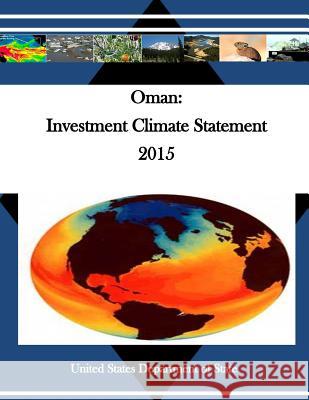Oman: Investment Climate Statement 2015 » książka
Oman: Investment Climate Statement 2015
ISBN-13: 9781530701353 / Angielski / Miękka / 2016 / 30 str.
Oman: Investment Climate Statement 2015
ISBN-13: 9781530701353 / Angielski / Miękka / 2016 / 30 str.
(netto: 56,57 VAT: 5%)
Najniższa cena z 30 dni: 55,53 zł
ok. 13-18 dni roboczych
Dostawa przed świętami

Darmowa dostawa!
Oman, officially known as the Sultanate of Oman is located in the southeastern coast of the Arabian Peninsula. Oman is an absolute monarchy, governed since 1970 by Sultan Qaboos bin Said. Overall, Oman's investment climate is conducive to U.S. investment. Omani officials and businesspeople generally value U.S. technology, skills, and expertise in a wide range of fields, count on U.S. firms' reputation for reliable, transparent business practices, and are keen to leverage U.S. business models, corporate values, and entrepreneurial culture in order to take advantage of the United States-Oman Free Trade Agreement (FTA). The FTA generates new opportunities for U.S. goods and services providers by providing a series of guarantees such as; duty exemptions, national treatment, non-discrimination in government procurement and the protection of intellectual property rights. However, persistent lack of compliance with duty exemptions guaranteed under Article 4 of the FTA, on the part of Omani Customs, as well as the imposition of a new Ministry of Oil and Gas program called In-Country Value, which as of January 1, 2014, requires local sourcing in the oil and gas sector. In addition, Omanization policy mandates which are aimed at replacing expatriate workers with local hires, and scarcity of gas for new manufacturing projects pose barriers for U.S. investment. Advantages of investing in Oman include: Oman's business-friendly environment, including the United States-Oman Free Trade Agreement; a modern business law framework; respect for free markets, contract sanctity and respect of property rights; relatively low taxes; and a one-stop-shop at the Ministry of Commerce and Industry for business registration; An educated and largely bilingual Omani work force; Quality of life: Oman is a safe, modern, friendly, and scenic country, with highly-ranked international schools, widely-available consumer goods, modern infrastructure, and a convenient and growing transportation network; Oman's geographic location, just outside the Persian Gulf and the Strait of Hormuz, along busy shipping lanes carrying a significant share of the world's maritime commercial traffic, with convenient access and connections to the Gulf, Africa, and the subcontinent; The steady and ambitious investment by the Government of Oman (GoO) in the country's infrastructure, including manufacturing free zones, seaports, airports, rail, and roads, as well as in its health care and educational systems and facilities. Foreign investment is rising in Oman as international firms recognize the growing opportunities related to the Sultanate's massive infrastructure investment program as well as increased efforts to diversify away from oil and gas, particularly with low world oil prices in late 2014 and early 2015. Non-oil economic growth stood at 8 percent last year, reflecting major infrastructure-related activity and the Sultanate's success in promoting downstream manufacturing in its free zones. Real GDP is expected to grow by 4 percent in 2014 and 4.5 percent in 2015, driven by a strong non-oil performance averaging 7 percent over the forecast period as the government's diversification ambitions, focusing on the tourism, industrial and manufacturing sectors, begin to have an impact. While declining world oil prices have not yet negatively affected Oman's GDP growth rate and while the GoO has publicly remained committed to continuing spending on existing infrastructure projects and other investments, realistically, continued depressed world oil prices could cause the government to become more conservative in their future spending on government-sponsored projects.











